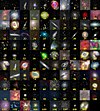NGC 362
| Kugelsternhaufen Daten von NGC 362 | |
|---|---|
(c) ESA/Hubble, CC BY 4.0 | |
| Der Kugelsternhaufen NGC 362 aufgenommen von Hubble-Weltraumteleskop | |
| AladinLite | |
| Sternbild | Tukan |
| Position Äquinoktium: J2000.0, Epoche: J2000.0 | |
| Rektaszension | 01h 03m 14,2s [1] |
| Deklination | −70° 50′ 54″ [1] |
| Erscheinungsbild | |
| Konzentrationsklasse | III [2] |
| Helligkeit (visuell) | +6,40 mag [3] |
| Winkelausdehnung | 14' [4] |
| Farbexzess E(B-V) (Rötung) | 0,05 [3] |
| Physikalische Daten | |
| Zugehörigkeit | Milchstraße |
| Integrierter Spektraltyp | F9[3] |
| Rotverschiebung | (746 ± 2) · 10−6 [5] |
| Radialgeschwindigkeit | (+223,5 ± 0,5) km/s [5] |
| Entfernung | ca. 28000 Lj (ca. 8500 pc) [6] |
| Absolute Helligkeit | −8,26 mag [3] |
| Konzentration lg(rt/rc) | 1,94 [3] |
| Metallizität [Fe/H] | −1,16 ± 0,25 [6] |
| Geschichte | |
| Entdeckung | James Dunlop |
| Entdeckungsdatum | 1. August 1826 |
| Katalogbezeichnungen | |
| NGC 362 • C 0100-711 • GCl 3 • ESO 51-SC13 • Mel 4 • Dun 62 • GC 193 • h 2375 | |
NGC 362 ist die Bezeichnung für einen galaktischen Kugelsternhaufen im Sternbild Tukan am Südsternhimmel. Er liegt von der Erde aus gesehen im Vordergrund des Außenbereichs der kleinen Magellanschen Wolke und ist etwa 27.000 Lichtjahre von der Sonne entfernt. NGC 362 hat eine scheinbare Helligkeit von +6,40 mag und ihr Kernradius beträgt 0,17 Bogenminuten.
Das Objekt wurde am 1. August 1826 vom schottischen Astronomen James Dunlop entdeckt.[7]
Der Kugelsternhaufen NGC 362 (oben rechts, gelblich) aufgenommen von GALEX; links unten ist der Außenbereich (bläulich) der kleinen Magellanschen Wolke erkennbar
Weblinks
- GoBlack
- GALEX
- astronews.com: Bild des Tages 25. Oktober 2016
- Youthful NGC 362 (engl.)
Einzelnachweise
- ↑ NASA/IPAC EXTRAGALACTIC DATABASE
- ↑ Harlow Shapley, Helen B. Sawyer: A Classification of Globular Clusters. In: Harvard College Observatory Bulletin. Band 849, 1927, S. 11–14, bibcode:1927BHarO.849...11S.
- ↑ a b c d e William E. Harris: A Catalog of Parameters for Globular Clusters in the Milky Way. In: Astronomical Journal. Vol. 112, Oktober 1996, S. 1487f. bibcode:1996AJ....112.1487H
- ↑ SEDS: NGC 362
- ↑ SIMBAD-Datenbank
- ↑ a b P. Székely u. a.: RR Lyrae stars in the southern globular cluster NGC 362. In: Astronomy and Astrophysics. Vol. 463, Issue 2, Februar 2007, S. 589ff. bibcode:2007A&A...463..589S
- ↑ Seligman
Auf dieser Seite verwendete Medien
Autor/Urheber: Roberto Mura, Lizenz: CC BY-SA 3.0
Caldwell Catalogue objects.
This image is a false color composite, where light detected by GALEX's far-ultraviolet detector is colored blue, and light from GALEX's near-ultraviolet detector is red.
(c) ESA/Hubble, CC BY 4.0
Youthful NGC 362
Globular clusters offer some of the most spectacular sights in the night sky. These ornate spheres contain hundreds of thousands of stars, and reside in the outskirts of galaxies. The Milky Way contains over 150 such clusters — and the one shown in this NASA/ESA Hubble Space Telescope image, named NGC 362, is one of the more unusual ones.
As stars make their way through life they fuse elements together in their cores, creating heavier and heavier elements — known in astronomy as metals — in the process. When these stars die, they flood their surroundings with the material they have formed during their lifetimes, enriching the interstellar medium with metals. Stars that form later therefore contain higher proportions of metals than their older relatives.
By studying the different elements present within individual stars in NGC 362, astronomers discovered that the cluster boasts a surprisingly high metal content, indicating that it is younger than expected. Although most globular clusters are much older than the majority of stars in their host galaxy, NGC 362 bucks the trend, with an age lying between 10 and 11 billion years old. For reference, the age of the Milky Way is estimated to be above 13 billion years.
This image, in which you can view NGC 362’s individual stars, was taken by Hubble’s Advanced Camera for Surveys (ACS).
Credit:
ESA/Hubble & NASA
Coordinates Position (RA): 1 3 14.63 Position (Dec): -70° 50' 58.20" Field of view: 2.63 x 2.65 arcminutes Orientation: North is 200.0° right of vertical
Colours & filters Band Wavelength Telescope Optical B 435 nm Hubble Space Telescope ACS Optical R 625 nm Hubble Space Telescope ACS Optical H-alpha 658 nm Hubble Space Telescope ACS.





